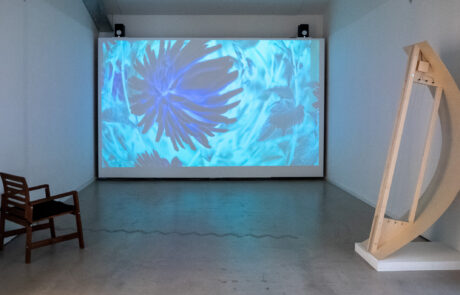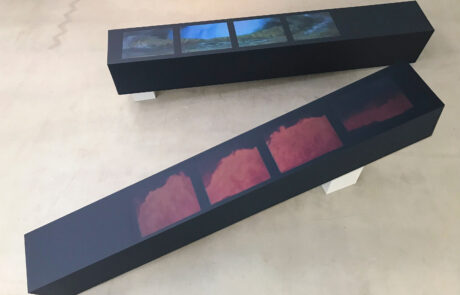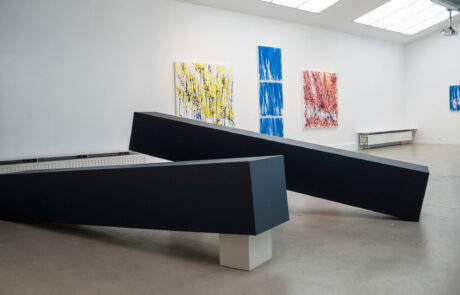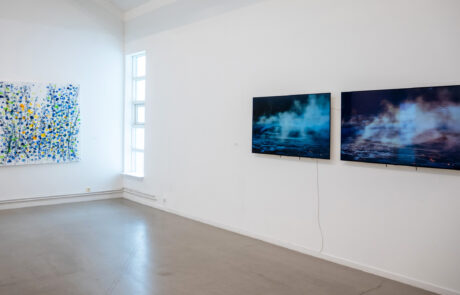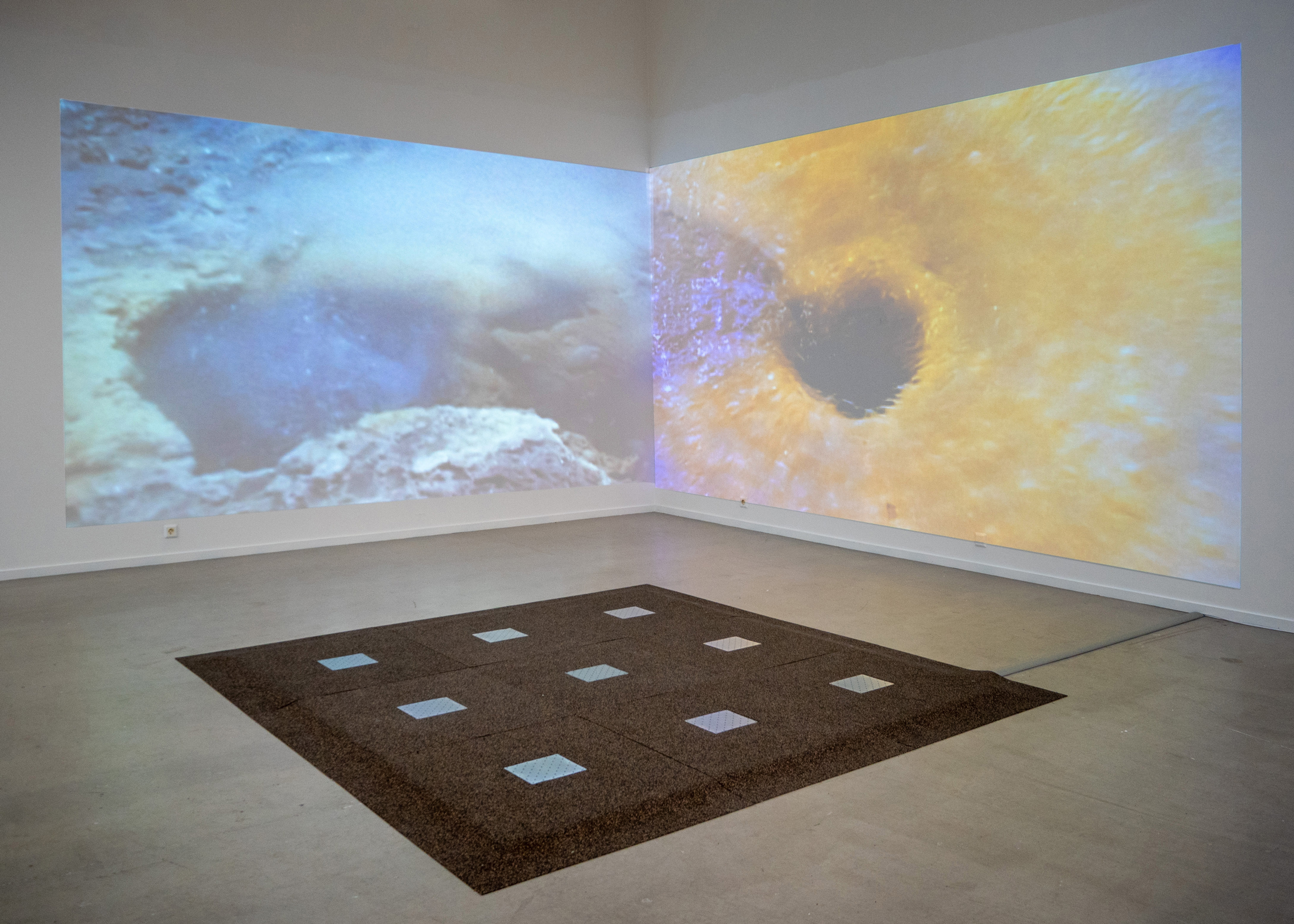
HVER / GERÐI
Sigrún Harðardóttir
May 19 – August 6, 2018
Artists have often presaged new technological developments through unexpected contexts. The idea of the internet, for example, our most ever-present public involvement with new media that currently exists, was at first rejected by the technology community as a backwards idea. The Argentinean novelist, Jorge Luis Borges described in his short story, “The Garden of Forking Paths”, a multi-layered storyline that combines a narrative within the labyrinth of a garden maze, presenting a novel that can be read in many ways, like a hypertext. “The garden of forking paths is an enormous riddle, or parable, whose theme is time…,” the author wrote in 1941, decades prior to the public knowledge of the computer. Within this short story, he invents a novel while describing a theory of the universe based on a structure in which everything is possible and occurring on some level of reality simultaneously.
For the types of new media that exist today, experimentation and technological engineering require great skill in developing these systems of programming. However, none would exist if it were not for visionaries who plotted the many possibilities that actions may take and in this way planted the seed of possibilities for scientists and artists in the future. The links between art and science as processes have been more than accounted for, especially the way in which both share a common discovery principle in which what is revealed presents a new known in the world.
This is a telling entry into the work of Sigrún Harðardóttir whose approach is as artist and scientist, painter and engineer, musician and video artist. Her trajectory, beginning with her initial interest in printmaking and painting and then later development with interactive technology and video art, spells out many of the same experimental and open narratives that trace the larger history of the moving image leading up to our current technological condition.
In the exhibition HVER / GERÐI, Sigrún combines elements of interactivity and sensory technology, allowing the viewer to initiate and experience a plethora of possibilities in combining action with effect, color, sound, and combinations in between. Interspersed with these interactive environments and sculptural installations are her paintings, allowing the visitor to experience firsthand the shifting aesthetic effect that occurs in the transition between traditional and technical images while exploring the synesthetic experience of audiovisual immersion.
During the 25 years that Sigrún lived away from Iceland, she remained inspired by her memories of the depth of colors in the Icelandic landscape. It was especially the depth of blue in the distance that would inspire her use of light and color in her paintings.
Like the mysterious hypertext novel based on time described in the labyrinthine garden of Jorge Luis Borges, Sigrún´s exhibition presents the visitor with an open narrative system of interactivity with natural elements in which the outcome is unknown. In a similar manner, the title of the exhibition can have many interpretations when translated into English. Hver can mean ‘who?’ but it is also a word for geyser. Gerði can mean ‘garden’ but when placed after hver, it asks the question, ‘Who did it?‘
So, dear viewer… hver gerði?
Shifting Notions of the Sublime
Sigrún Harðardóttir began her long career in the arts in the printmaking department at The School of Visual Arts and Crafts, which would later become Iceland University of the Arts. These print-related techniques can be seen in her current paintings in which she uses textured objects to drum the paint onto the canvas. This exploration of print-related techniques and later involvement in moving image technology represents not only her personal shift in exploring the movement from analog to digital images but the cultural shift as well. Her works represent the original impetus to represent and reference the effect of natural landscapes on the senses through visual art and how it has been carried out through the centuries, especially in Iceland.
The aesthetic notion of the Sublime, of a beauty that is both dangerous and exalted, is especially relevant in the exhibition as it inherently carries within its meaning the many dichotomies on display. In the 17th and 18th centuries, the Sublime was most associated with nature and it was only later in the 20th century that it began to be replaced with more technological concerns as our sense of amazement and fear shifted to factories, weapons, and the unwieldy power and infinite possibilities suggested by computers.
With Sigrún’s representations in HVER / GERÐI drawn from images in the Icelandic landscape, there is an inherent Romantic connotation. Inspired by the watercolors of Ásgrímur Jónsson whose works she grew up with, the transparency in his works would remain with her in her exploration with video art and painting effects. Ásgrímur Jónsson (1876 – 1958) essentially brought Icelandic art into the 20th century. He was seeking direct visual equivalent to the Icelandic landscape in his paintings, which were met with great approval from the public who seemed to have found an artist whose vision of landscape equaled the Romantic poets.
While Ásgrímur Jónsson was preoccupied with coming to terms with the visuals of the Icelandic landscape, it was his student, Johannes Kjarval (1885 – 1972) who used landscape as a springboard into the fantastical, focusing on a unique perspective in which traditional increments for land, sea, and sky are shifted so that the distant becomes the close at hand.These visual experiments in the landscape by Kjarval were also an early inspiration for Sigrún.
In the exhibition, her works are a direct reflection of the subject matter, repeating themes that the artist has worked with in various ways throughout her career while offering a new perception of the subject matter each time. The geyser, Stokkur, the second largest geyser in Iceland and Europe and the largest active geyser today, is a main character in many of her works. Its variability is witnessed in the way Sigrún approaches its rhythmic quality in The Rhythm of Geysers (2004), powerful visual presence in Öndvegissúlur (1995), and changeable nature in Gaia Breathing Variation III and IV (2017).Gaia Breathing, Sigrún’s most travelled video, has been distributed and shown in museum and video festivals all over the world through Video Femme in France and the Iceland-based video festival, 700IS Reindeerland.
As in her videos of geysers, her paintings representative of geysers capture the movement and action of the phenomenon in a fluid manner that seems to exist on and off the canvas. The action used to create the paintings arrest the same scene over and over to capture the living changingness of light and its myriad effects. The garden paintings began in a dialogue between the grand piano and the canvas during a performance enacted by Sigrún at Reykjavik Art Museum – Hafnarhús in 2013. This performance marked the beginning of the artist’s use of repetition in her continuing investigation of texture, colors, and transparency.
Öndvegissúlur
Sigrún takes inspiration from ancient stories as well, a fixation common in many works by Romantic painters and poets. Sigrún brings to materiality the mythical pillars drawn from the story of the settling of Reykjavik by Ingólfur Arnarsson in 874. The two pillars in the exhibition are modeled after the pillars that the chieftain took from his high seat in Norway, tossed into the ocean, and vowed to build his farm where they came to shore, which was just off the coast of Reykjavik. The two pillar sculptures, originally from an installation by Sigrún from 1995 called Öndvegissúlur, also represent the double-edged nature of the Icelandic landscape that is at once both beautiful and at times a very dangerous and unstable part of the earth.
The pillars tell of these mythical storylines as well as a direct and expansive communion with the natural world. They are metaphorical in their duplicity as they represent a duality that can also be found in nature. Projected onto the two pillars are images of volcanic eruptions and geothermal activities, representing the mythical image of the pillars´ owner being a spiritual leader as well as a warrior. Both geysers and gardens depict sustainable relationships between man and nature, not a mythical untouched wilderness that is the gold of frontierism, but the long, slow steady cultivation of a mutual relationship that is imbedded in cultural history and mythology.
The great abundance and flourishing of life that can coexist with great destruction and danger, for instance, can be found in the natural elements of the town of Hveragerði itself. The town’s hot springs formed the economic basis for its foundation as well as being connected to a monumental destructive volcanic force.
Sigrún´s fascination with geysers began with her childhood tradition of going on Sunday tours to visit the geysers, similar to how Sundays in other parts of the world would be spent visiting the zoo. Sigrún didn’t start working with the geysers as a theme until she stayed in an art residency in Hveragerði during the summer of 1996, which gave her inspiration to work with that phenomenon that brings her continual fascination. In an art residency at Hafnarborg Center for Art and Culture in Hafnarfjorður in 1997, she continued her work with geysers that were also exhibited in a solo show, hver/hvar, in Hafnarborg that year. In the exhibition, Sigrún worked with the energy and pressure of nature through a video and sound installation. In her installation, she brought to the foreground the impression that geothermal surface activities in their original form are slowly disappearing. The geothermal surface activity in Reykjavik was all harvested in 1930 so there are none that remain untouched.
The Immersive Audiovisual World of the Senses
In the Romantic tradition, the pure worship of nature and its allegories went further than mere contemplation of the scene. The German Romantic painter, Caspar David Friedrich (1774 – 1840), for example, often displayed his figures with their backs to the foreground in order to allow the viewer to imaginatively place themselves in the eyes of the figure in an effort to sink his personality into the landscape in order to understand from within the landscape its forms and transformations.
This subjective feeling for what was alive in the landscape was rendered through the natural shifts and seasonal cycles of light and weather that Sigrún translates through a rhythmic affinity with the motion of geysers and a representation of them in a variety of color palettes. Friedrich attempted to represent the material landscape through personal affinity with it and inspire the viewer to take part in this discovery with him. In Sigrún´s exhibition, the figure with their back to the viewer is replaced by the playful interactivity between visitors and the various sensors installed which allow the viewer to take part in the co-creation of the space.
In 1986, Sigrún presented Dawn, a 6-minute installation piece with three monitors, three players and a synchroniser on the picturesque, forested hill at Öskuhlið in Reykjavik. The presentation began at midnight in July, a time when theMidnight Sun still casts a hazy glow. Documentation of the event shows hundreds of people standing in the outdoor setting facing the night sky with Sigrún´s monitors in the foreground showing a fleeting imagery progressing between realistic and abstract images.
The first installation of its kind in an outdoor setting in Reykjavik at the time, the event announced Sigrún´s presence as a forerunner of new media art developments in Iceland. The work was later broadcast on the State Radio and Television Station in Iceland in January 1987. The video presented the transformation of realistic images into abstract ones and their ongoing reciprocal shift through the visuals of feedback through layer after layer of abstraction, a feat inspired by the Vasulkas. The name of the work, Dawn, reflects the overlapping of subconscious and conscious thought especially in the hours before waking. A copy of the work was bought by Rijksakademie van beeldende kunsten in 1986 and by Reykjavik Art Museum in 2013 who exhibited it most recently in 2017.
Sigrún´s predecessors in video art and pioneers in the field, Steina (1940, Iceland) and Woody Vasulka (1937, Czechoslovakia), experimented with audio and visual input to create works such as Noisefields (1974) which is a representation of the dual input of audio and visual noise through a Video Sequencer. The first generation of video artists could be seen as representative of the first instance of the two trajective histories of visual art and music meeting in a common physical audiovisuality. The intermedial spaces between music, film, sculpture, and architecture allowed this duality to be digested in the technology which projected music as visual image.
Sigrún was introduced to film, sound, and video art during her studies at the Rijksakademie van beeldenden kunsten in Amsterdam where she studied from 1982 to 1986. During this time, Sigrún was already working with experimental performances and immersive environments, projecting 8mm film onto dancers, for example. In 1985, Sigrún was invited by the Rijksakademie to participate in a workshop at MonteVideo in Amsterdam, a center for the study of electronic images, given by Steina and Woody Vasulka, who would become a great influence. She was a member of a group of media artists and their influential gallery, Time Based Arts, as well as being a member of their publication committee during her years in Amsterdam. Time Based Arts would later become part of MonteVideo and eventually Netherlands Institute for Media Art, which is now called LIMA who actively distributes two of Sigrún’s works.
Sigrún works between the realms of the audiovisual in many different capacities. For the exhibition in Hveragerði, she has created an interactive installation, HVER / GERÐI, in collaboration with the engineer and lecturer at Reykjavik University, Joe Foley. Sigrún and Foley were also teaching a class called Electro Mechanical Interactive Art in 2011, a joint collaboration between the Engineering Department at Reykjavik University and the Fine Art Department at Iceland Art Academy. The interactive installation is a literal blending of the interactivity between touch, pressure, and movement as sensors in different elements of the installation trigger playback of audio and visual to create a multi-sensory experience. The installation’s components of musical instrument, chair and distance sensor trigger sounds and visuals particular to the surrounding natural area, such as the sounds of birds and bees and the images of flowers and gardens, as well as the sound and image of the type of bubbling mud geyser that is common in Hveragerði.
The interactive video installation, The Rhythm of Geysers (2004 – 2016), will also be prominent in the exhibition. The work is an interactive video installation that brings to the foreground the musical diversity of the geothermal site as well as a symbiotic relationship with the visitor. In order for the piece to evolve, the visitor participates by creating their own rhythmic combination from the interactive floor piece containing 9 pressure sensors and 38 video outcomes. Minimizing the distance between the audience and the artist, the work makes a gesture to the audience to create their own combination of sound and image.
“The different geysers are the musical instruments of this work,” writes the artist, “and the musical harmony is created by the different rhythms and pitches reached at different stages of an eruption. The Rhythm of Geysers is a poem to the earth…”
The work was first exhibited in 2004 at the University of Quebec in Montreal, Canada and was last exhibited in 2016 in the Vasulka Chamber at The National Gallery of Iceland, who bought the work.
Sigrún follows a long line of prominent artists whose work involves art and technology in responsive environments including Robert Rauschenberg, Jean Tinguely, and John Cage. In her symbiotic painting performance during the opening of the exhibition, she paints a canvas placed upon a specially built resonator using modified drumsticks in a dialogue with the musician Leifur Gunnarsson playing a contrabass. Another performance takes place on June 23, a conversation between Sigrún on the canvas and Alexandra Kjeld on the contrabass. The resulting paintings created from the dialogues will be displayed in the exhibition along with a video documentation of the performances.
From the Traditional Image to the Technical Image
Sigrún proves that there is a Sublime to be found in media art by breaking down video elements through painterly gestures in the manner of Stan Brakhage, the American experimental filmmaker whose immersive works studied the effects of light moving through glass in The Texture of Light (1974), a work reminiscent of Impressionist painters. Similarly, it is possible to trace Sigrún’s personal history of arriving from music and painting to video and these other forms of multi-dimensionalities through multi-sensory technology.
The German media theorist Friedrich Kittler argues that the technical contents of media, i.e. a pixel-composition, require visuality beyond human optics. He describes, for example, how computer graphics are composed of a coordinated space of two-dimensional pixel groups, each made up of a variety of primary color densities. Similar to a pre-cinematic use of paint on a canvas but without the painterly gestures, the culture of image manipulation now lies in photo-shop technologies and all of its intricacies and capacities.
In Sigrún’s oeuvre, there is a continuous thread in which electronics are a source of poetic language as well as sentiment that video is a type of electronic paintbrush. The moving image becomes a phenomenology that can be expressed on the screen, as well as something that can be continued across all mediums. In a work by Sigrún from 1990 titled Painted Conversation, five monitors become part of five metal sculptures that are placed humanlike in a circle. Through the abstract images, the structure of dialogue itself is explored in which the content becomes less important than the expression of emotions between the participants. The psychology of interacting through the medium of imagery reveals the structure of communication as it relates to personal and social environments. The 1-hour installation presented videotapes made with the paint box of the Fairlight Effect Machine.
The Fairlight Effect Machine, premiered in 1984, was extremely advanced for its time as it allowed the user to record the painting created with the machine in real time using many different effects. The Fairlight presents a crucial body of instrumentality that marks a transition point not only in Sigrún’s career, but in the larger transition of how aesthetics are conceived in the visual arts. Her trajectory, beginning with her initial interest in printmaking and painting and then later development with interactive technology and video art, spells out many of the same experimental and open narratives that trace the larger history of the moving image leading up to our current technological condition. Through a sensibility and fascination with Iceland’s natural phenomena that she has sustained throughout her career, Sigrún follows in the Romantic tradition, taking inspiration from nature and its allegories and going further than mere contemplation as a spectator of the landscape.
In Sigrún’s immersive, responsive installations, she offers the audience the transformative effect on the body when things such as sound and color are experienced as different sensations than how they are normally perceived. This is the transcendent quality in action in her works, as the viewer is invited to sense sensation itself in a way that could be considered synaesthetic. Sigrún’s approach creates a multi-layered narrative not only in the exhibition HVER / GERÐI but in the decades of exploring her artistic vision as well. Like the labyrinth of a garden maze of paintings and electronic images that can be read in many ways, Sigrún links art and science as processes that reveal a common discovery principle in which what is revealed presents a new known in the world. The perception of artists is an inseparable part of Icelandic culture, just as the information gathered from the senses are not facts located distantly from cultural history. Sigrún’s work reveals the way in which vision itself, not just our relationship to the arts, has changed throughout history.
Curator: Erin Honeycutt
(b.1989) Erin is from the US and has resided in Iceland for many years. She studied art history at the University of Iceland and specialized in video and new media. She is a freelance curator and writer, and has written articles for museums, galleries, and magazines in Iceland and abroad with the subject mainly on Icelandic art. Erin has also done research at the Vasulka Chamber of the National Gallery of Iceland and has taught the course A Survey of Video and Experimental Film at the University of Iceland. She was the curator of a selection of Icelandic video art that was exhibited at the Addis Video Art Festival in Ethiopia in January 2018 and was a co-curator of the Video Art Program that was opened at Keflavik International Airport in December 2017, which also included a work by Sigrún Hardardóttir.
About the artist:
Sigrún studied visual arts at the Iceland College of Art and Crafts from 1978–82 and the postgraduate program in visual arts at the Rijksakademie van beeldende kunsten in Amsterdam from 1982-86, where her subjects were cinematography, video and sound-mixing, among others. From Holland Sigrún moved to Canada where she worked as an artist and also taught for five years in the design department of the Université du Québec á Montréal. She then matriculated into the communication department at the same university in 1999 and finished with a Master’s degree in multimedia focusing on interactive installations in 2005. Sigrún then returned to Iceland after almost twenty-five years abroad. During her career, Sigrún has mainly been involved in painting, making various experiments in video and electronics, and in recent years, interactivity that she has developed in collaboration with the engineer, Joseph T. Foley, and worked on painting performances in collaboration with musicians.
Sigrún was a member of the Time Based Arts Gallery in the Netherlands from 1984-88 and worked in the publishing committee. She also participated in an artist run gallery in Canada, Galerie La Centrale in Montreal from 1990-95. She was one of the founders of LornaLab, a platform for artists and scientists in Iceland, with whom she participated in organizing workshops from 2010 to 2013. She also participated in the organization of the Raflost Festival and workshops of electronic arts in Reykjavik, Iceland in 2009 and 2012.
Sigrún has participated in exhibitions, both private and collective, in Iceland and abroad. Her works are found in public collections, such as the National Gallery of Iceland, Reykjavik Art Museum, Kópavogur Art Museum, Lima in the Netherlands, Ordigrap in Montreal Canada and in private collections such as that of Antonio and Janina Manchini in Toronto, Canada. Some of her video works are also in distribution to museum exhibitions and video festivals.
Here is a video of the exhibition filmed by the artist:



